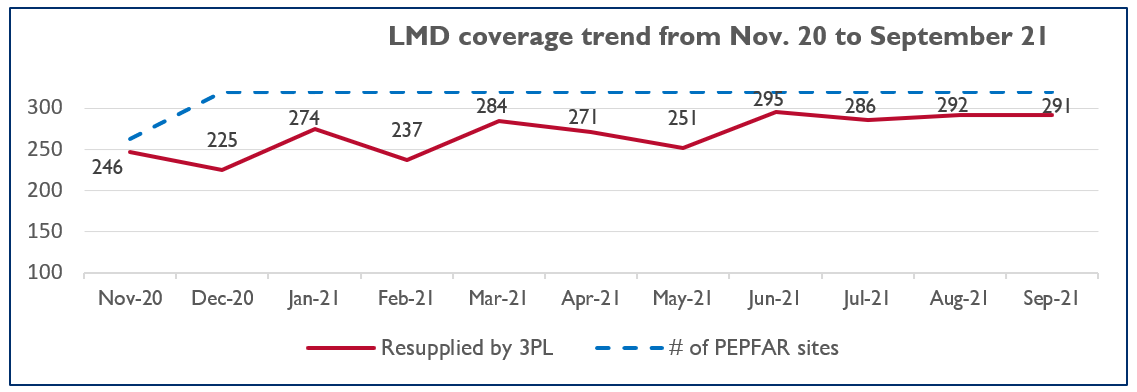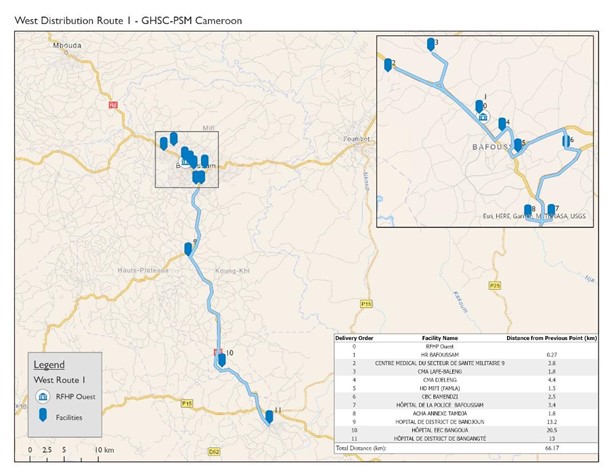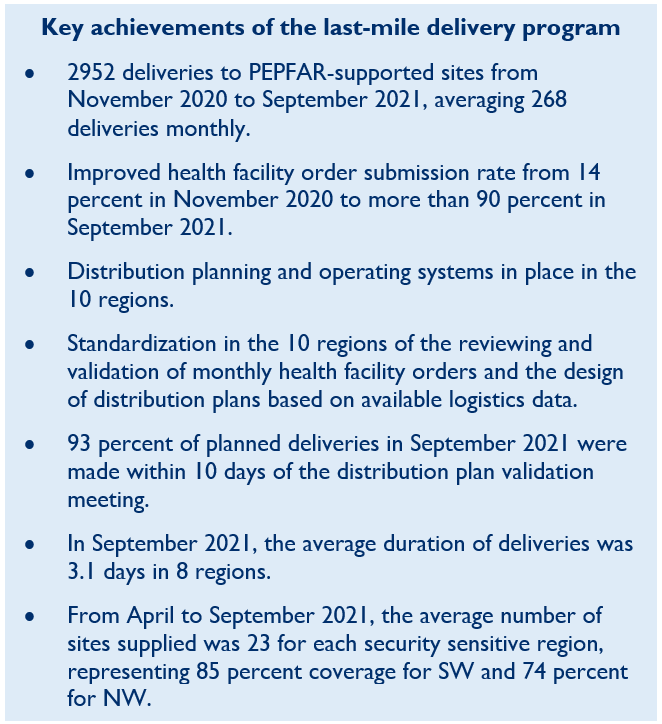
In Cameroon, the current supply chain of HIV commodities operates through a network that comprises the “Centrale Nationale d’Approvision-nement en Médicaments et Consommables Médicaux Essentiels’’ (CENAME), which ensures central storage and distribution down to 10 Regional Funds for Health Promotion (RFHPs) that are mandated to supply health facilities in all the districts.
As with many other program-funded commodities, CENAME and the RFHPs store and distribute HIV commodities under established remunerated sub-contracts. Despite the existence of sub-contracts in some regions where the USAID Global Health Supply Chain Program-Procurement and Supply Management (GHSC-PSM) project has historically operated supporting the U.S. President’s Malaria Initiative (PMI), distribution to the last mile remains a challenge due to limited fleet at CENAME and RFHPs. This is compounded by poor management of the available fleet. At times, deliveries do not take place due to a lack of funds, resulting in health facilities picking up medicines themselves using motorbikes, public transport, or other vehicles, including ambulances. Furthermore, the absence of reliable LMIS and WMS limit the visibility on the supply chain and the decision capacities in the RFHPs, at CENAME, and at the national level.
In 2020, to address these issues and increase the availability on HIV commodities down to health facilities, GHSC-PSM implemented an initiative that included strengthening management at various levels of the public health supply chain and leveraging private-sector, third-party logistics (3PL) service providers to ensure deliveries of HIV commodities. GHSC-PSM’s approach aimed to guarantee regular deliveries while ensuring distribution of available products to the maximum number of health facilities. The initiative took place in the context of a transition to optimized ARV treatments (dolutegravir-based regimens).

GHSC-PSM established monthly delivery cycles, with regional logistics officer providing direct support to each of the 10 RFHPs for the management of warehousing and inventory, and the organization of distribution. To consolidate the efforts of regional partners, GHSC-PSM supported the institutionalization of monthly meetings to jointly analyze logistical data and validate health facility data and achieve efficient distribution cycles. In addition, GHSC-PSM encouraged quarterly distribution cycle review workshops to adapt best practices based in lessons learned.
GHSC-PSM also strengthened support in the large Littoral and Center regions through a variety of supply chain management activities. These efforts served to streamline the overall country supply chain to help push on-time product delivery from the central level to RFHPs for optimized last-mile delivery cycles.
GHSC-PSM also established a contract with a 3PL service provider to distribute products from each of the ten RFHPs to the 320 health facilities supported by the U.S. President’s Emergency Plan for AIDS Relief (PEPFAR), where 80 percent of the active HIV patients receive services. The project developed optimized distribution routes for the 3PL providers for all 320 facilities across all 10 regions with clearly defined routes and defined distribution plans. This enabled project staff to inform the health facilities of expected delivery times and provided increased ability to supervise the performance of the 3PLs, thereby optimizing resources and delivery times. A new internal transport information system and real-time tracking platform allow monitoring of vehicle movements by GPS and proofs of delivery. The project focal person monitors the location of all commodities as they move through Cameroon. At any time during transit, if a vehicle deviates from an intended route, project team members immediately contact the driver and notify facilities of potential delays.

Using KoBo Toolbox—a free an open-source suite of tools for field data collection—all proofs of delivery are recorded and stored centrally, confirming the receipt of commodities to each facility. Now, when the Regional Technical Working Group focal person is unable to confirm delivery at PEPFAR sites, s/he turns to the project focal person for quick access to available data.
The implementation of these actions has improved coordination of supply chain activities at the regional level and increased visibility from regional warehouses to facilities. This resulted in greater involvement and collaboration between the RFHPs, the HIV regional technical groups, the Procurement and Supply Management Unit of the Regional Delegation of Public Health (RDPH), and clinical partners. The last-mile delivery initiative also benefitted other programs: improvement in the regularity of deliveries to non-PEPFAR sites by RFHPs.



